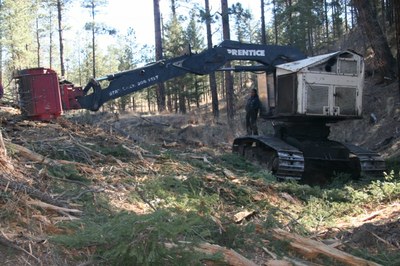Cover Applications
Dry Mulch
What – Straw, woodchips or fiber materials are applied to burned areas using ground or aerial application.
Purpose – By providing immediate ground cover, mulch is intended to reduce surface erosion, reduce downstream peak flows by absorbing rainfall, and secure seeds stored in the soil or applied as emergency treatment. Mulch also provides favorable moisture and temperature regimes for seed germination.
Effectiveness – Straw mulch was reported as highly effective in reducing surface erosion when application rates exceeded 60% ground cover, and sometimes effective in reducing runoff. Sites prone to high winds reported reduced effectiveness. A combination of mulching and seeding was reported as more effective than seeding alone in regards to germination, but not necessarily in regards to surface cover. Wood based mulches (manufactured products and shredded on-site trees) were equal to or more effective than straw mulch in reducing post-fire erosion.
Where
- Areas with moderate- or high-burn severity.
- Due to cost, there usually needs to be prioritization for mulch application, focusing on where there is a threat to life and property. This may include steep slopes adjacent to communities, roads, and infrastructure; critical headwaters that feed municipal water supplies; and waste sites that pose serious environmental threats.
Cost – Straw aerial application $250–930 per acre; ground application $425–1200 per acre. Based on 1–2 tons per acre application rate (provides average mulch depth of 1–2 inches). Wood based aerial application $1500–2000. Additional factors include:
- Location and access.
How to Link – See USDA BAER Catalog page 27 (PDF page 35).
Wet Mulch (Hydromulch)
What – Combinations of organic fibers (e.g., wood shreds, paper, cotton, flax, etc.), tackifiers (i.e., glue), suspension agents, and seeds are mixed together with water and applied to the soil surface via ground or aerial applications.
Purpose – The matrix formed by hydromulch creates an immediate cover and holds moisture and seeds on steep slopes, which fosters seed germination while holding soil in place.
Effectiveness – Hydromulch may reduce sediment yields during the first few rainfall events (long-term effectiveness is unknown). Treatments are more effective on short slope lengths vs. longer slopes due to susceptibility to concentrated flows. This method is wind resistant. Multiple factors impact effectiveness (e.g., application rates, slope length and steepness, make/brand of tackifier).
Where
- Aerial application on inaccessible, highly erodible soils following moderate or high fire severity.
- Ground application on highly erodible soils near roads.
- Due to cost, there usually needs to be prioritization for mulch application, focusing on where there is a threat to life and property. This may include steep slopes adjacent to communities, roads, and infrastructure; also critical headwaters that feed municipal water supplies, and waste sites that pose serious environmental threats.
Cost – $2000–3000 per acre for aerial application; $1675–3000 per acre ground application. Additional factors include:
- Location and access
- Helicopter/fixed-wing aircraft turnaround time
- Helicopter/fixed-wing aircraft production rate
How to Links – See USDA BAER Catalog pages 15 and 22 (PDF pages 23 and 30); and NRCS Hydromulching Fact Sheet.
Slash Spreading

What – Felling, lopping, and then scattering trees and brush by hand or mechanical equipment.
Purpose – Intended to provide increased ground cover to reduce raindrop erosion.
Effectiveness – Scattering slash created by chain saw is generally ineffective due to slow labor production rates and the large amount of material needed for adequate soil cover. However, mechanized equipment (e.g., hydro ax) that masticates material is considered moderately effective.
Where
- Burn sites with moderate or high fire severity.
Cost – $220–1000 per acre. Additional factors include:
- Topography.
How to Link – See USDA BAER Catalog page 33 (PDF page 41).
Seeding
What – Aerial and ground application of seed across large areas. Native seed mixes are preferred, but non-invasive, non-native seed mixes are also used, often with sterile annual grass seeds or cereal grain seeds.
Purpose – Intended to reduce soil erosion.
Effectiveness – Seeding was generally reported as ineffective (i.e., provided < 60% surface cover) the first year following fire and neutral in subsequent growing seasons following fire. However, when combined with mulching, the potential for germination may increase as a result of seed and moisture being held by mulch. Sterile annual seeds and cereal grain seeds that germinate can reduce soil erosion after fire, yet not compete with native grasses in subsequent years. Please note that seeding has the possibility for introducing invasive and noxious species, so be aware of this possibility.
Where
- Hillslopes with moderate and high fire severity.
Cost – $20–170 per acre. However, trend analysis indicated costs increased over time (Peppin et al. 2011). Additional factors include:
- Availability of seed
- Number of species in seed mix
- Implementation time frame
- Number of landowners involved
- Elevation and climate
- Size of fire
- Aircraft type
- Topography
- Proximity of treatment blocks to staging areas
- Weather conditions during seeding
How to Links – See USDA BAER Catalog page 64 (PDF page 72); and NRCS Seeding Fact Sheet.
Soil Scarification (with Seeding)
What – Hand tools or mechanical equipment are used to break up and loosen topsoil to increase surface roughness.
Purpose – Intended to break down hydrophobic layer, prepare seedbed, and increase infiltration rate.
Effectiveness – Generally, this treatment did not provide significant improvement (e.g., reduced sediment yield) as compared to no treatment (Rough 2007).
Where
- Areas of high- and moderate-burn severity.
- Slopes with high erosion potential.
Cost – $245–300 per acre for hand crew; $50 per acre for ATV use. Additional factors include:
- Location and access
How to Links – See USDA BAER Catalog page 60 (PDF page 68); and NRCS Mechanical Scarification Fact Sheet.
